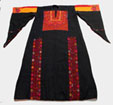Embroidering Identities:A Century of Palestinian Clothing
Traditional Clothing from Palestine on Exhibit at the Oriental Institute Museum

An exhibit of 19th and early 20th century clothing from Palestine will be shown at the Oriental Institute Museum from November 11, 2006 to March 25, 2007. The exhibit entitled “Embroidering Identities: A Century of Palestinian Clothing” is a joint project of the Oriental Institute of the University of Chicago and the Palestinian Heritage Center in Bethlehem. The exhibit opens in November 2006 in celebration of Arab Heritage month.

The exhibit explores the issue of personal and regional identity and how it was expressed through clothing. It also shows the beauty, technical achievement, and tremendous diversity of the garments. In the days before globalization and the homogenization of culture though television and cinema, clothing was an important cultural marker that expressed not only geographic origin but also status. Until recent years, each region of Palestine had its own style of clothing for women characterized by distinctive patterns of embroidery, appliqués, sleeve design, and accessories. Although men's clothing did not express as strong a regional identity, it too showed considerable diversity.

Clothing was an important part of the culture—a significance that is now largely lost. Dressmaking skills were usually taught to girls from about the age of seven. The grandmother was the person responsible for teaching the skill of embroidery. People strongly believed that the personality of the future bride was revealed in the workmanship, color and design of her dresses. The girls started embroidering at a young age so their wedding trousseau would be full of lavishly embroidered items by the time they are ready to be married. The dresses were heirlooms that were passed from generation to generation. When finally outgrown, or too worn to be used, a garment might be turned into household rags. Fine embroidery pieces from the embroidered chest panel of a woman's dress were often kept to be re-sewn onto new garments.

The exhibit includes clothing from Jerusalem, Bethlehem, Ramallah, Jericho, Hebron, Beir Saba' and Gaza. Among the ensembles are traditional wedding gowns with their elaborate headdresses covered with coins and silver ornaments. The exhibit includes women’s dresses, shawls, and headdresses, and jewelry and men’s over cloaks and accessories.

The materials are drawn from the permanent collection of the Oriental Institute Museum of the University of Chicago and from the Palestinian Heritage Center in Bethlehem. The Oriental Institute's holdings were collected by members of the American Colony in Palestine in the early twentieth century. The late Clara Klingman donated the collection to the Oriental Institute in 1980. Most of the garments have never before been exhibited. The Palestinian Heritage Center in Bethlehem possesses a major collection of costumes and has a permanent display of its collection. The Center has also put together many shows and exhibits internationally.

Educational programming including lectures on the history of Palestinian embroidery and its regional variability. Hand-made embroidered items will be available for purchase at the Oriental Institute’s gift shop “The Suq”.
The Oriental Institute Museum is located at 1155 East 58th Street, Chicago. The Museum is open Tuesday, Thursday through Saturday from 10 a.m. to 6:00 p.m., Wednesday from 10:00 a.m. to 8:30 p.m., and Sunday from noon to 6:00 p.m. Suggested donation for admission is $5 for adults, $2 for children. For programs, call 773 702 9514.

